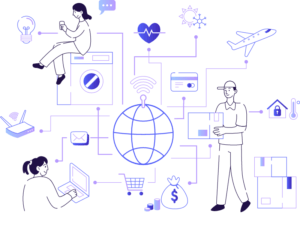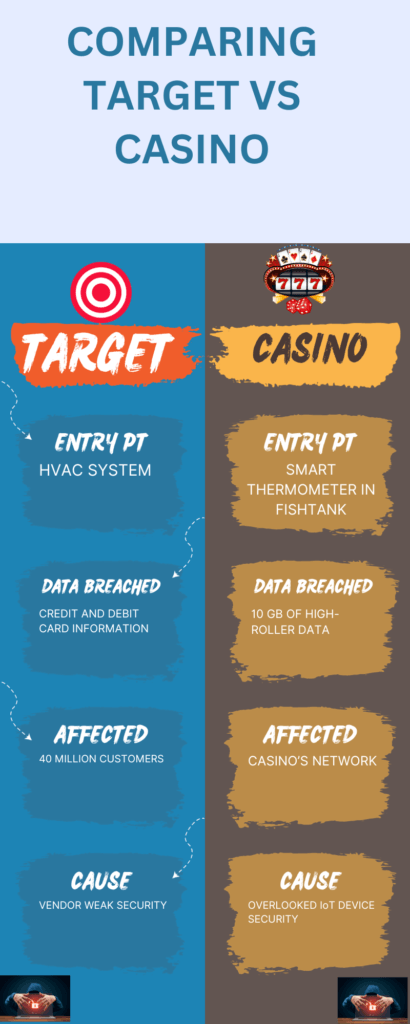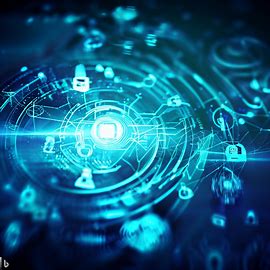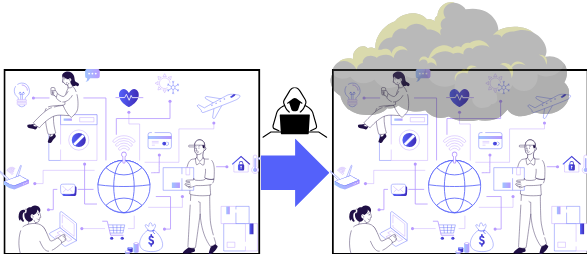
The Dawn of IoT: A Revolution in the Digital World
In today’s interconnected world, the Guide to IoT is more than just a primer; it’s a roadmap to understanding the digital revolution unfolding before our eyes. The Internet of Things, commonly known as IoT, has rapidly transformed from a futuristic concept into an integral part of our daily lives. From smart thermostats that adjust room temperatures to our preferences, to entire cities becoming “smart” with interconnected traffic systems, IoT is reshaping the way we live, work, and interact.
The rise of IoT signifies a monumental shift in the technological landscape. It represents the convergence of the physical and digital realms, where everyday objects are imbued with the power of the internet, allowing them to communicate, analyze, and act. This seamless integration offers unprecedented opportunities, especially for businesses looking to harness the potential of real-time data analytics, supply chain optimization, and enhanced customer experiences.
However, with great power comes great responsibility. As the adoption of IoT devices continues to surge, it’s crucial for businesses, especially small enterprises, to recognize the significance of this technology. It’s not just about leveraging the benefits but also understanding the associated risks, ensuring that as we step into this new era, we do so with awareness, preparedness, and a vision for the future.
The Evolution of IoT: A Timeline
Let’s look at the evolution of IoT as shown in the diagram:
- 1982: The inception of IoT began with the first IoT device, a Coke machine at Carnegie Mellon University (CMU), which could report its inventory and the temperature of the newly loaded drinks.
- 1999: The term “IoT” was coined by Kevin Ashton during his work at Procter & Gamble, marking the beginning of a new technological era.
- 2008: The first-ever IoT conference took place, indicating the growing interest and investment in this field.
- 2013: A significant milestone was achieved when the number of IoT devices surpassed the human population.
- 2018: The number of IoT devices globally reached a staggering 20 billion.
- 2023: It’s predicted that there will be around 50 billion IoT devices, showcasing the rapid growth and adoption of this technology.

Why Every Small Business Manager Should Understand IoT
In the ever-evolving landscape of technology, the Internet of Things (IoT) stands out as a game-changer, especially for small businesses. At its core, IoT is about connectivity, data, and automation. But its implications go far beyond just smart gadgets; it’s about creating smarter businesses.
IoT is Everywhere
IoT devices have permeated every facet of our lives and businesses. They’re not just limited to high-tech industries or large corporations. From surveillance cameras monitoring storefronts to thermostats optimizing office temperatures, IoT devices are everywhere. Even everyday objects, like coffee makers or door locks, are now being integrated with IoT capabilities. This ubiquity means that small businesses, regardless of their industry, will likely interact with or utilize IoT in some capacity.
The Transformative Power of IoT for Small Businesses
For small business managers, understanding IoT is not just about keeping up with technology trends; it’s about recognizing the transformative power of IoT and leveraging it to drive business growth. Here’s why:
- Operational Efficiency: IoT devices can automate routine tasks, monitor equipment in real-time, and optimize resource usage. This leads to reduced operational costs and increased efficiency.
- Data-Driven Decisions: IoT devices generate a wealth of data. By analyzing this data, businesses can gain insights into customer behavior, optimize inventory levels, and even predict equipment failures before they happen.
- Enhanced Customer Experience: With IoT, businesses can offer personalized experiences to their customers. For instance, a smart retail store can use IoT sensors to understand customer preferences and offer tailored promotions.
- New Revenue Streams: IoT opens the door to new business models and revenue streams. For example, a traditional product can be transformed into a service with the addition of IoT capabilities, leading to recurring revenue opportunities.
- Competitive Advantage: Early adoption and integration of IoT can give small businesses an edge over competitors, allowing them to offer innovative solutions and services.
In conclusion, the importance of IoT for small businesses cannot be overstated. It’s a tool that offers endless possibilities, from streamlining operations to unlocking new growth avenues. For small business managers, embracing IoT is not just a tech upgrade; it’s a strategic move to future-proof their business in a digital-first world.
The Unseen Benefits of IoT for Small Businesses
While the Internet of Things (IoT) often garners attention for its flashy gadgets and smart home devices, its true potential lies in the myriad of unseen benefits it offers to small businesses. These advantages, often operating behind the scenes, can revolutionize the way businesses operate, compete, and grow. Let’s delve into some of these transformative benefits:
1. Unparalleled Efficiency
IoT devices, by their very nature, are designed to automate and optimize. For small businesses, this means tasks that once required manual intervention can now be automated. Whether it’s smart lighting systems that adjust based on natural light or intelligent inventory systems that reorder stock when levels are low, IoT ensures operations run smoothly and efficiently. This not only saves time but also reduces the margin for human error.
2. Real-Time Data Analytics
In the age of information, data is king. IoT devices continuously gather data, offering businesses a real-time snapshot of their operations. This constant stream of information provides invaluable insights. For instance, a retailer can understand peak shopping hours by analyzing foot traffic data, or a restaurant can adjust its menu based on the popularity of dishes. This real-time data analytics capability allows businesses to make informed decisions swiftly, adapting to changes and capitalizing on opportunities.
3. Supply Chain Optimization
The supply chain, often a complex web of suppliers, logistics, and inventory, can greatly benefit from IoT integration. Smart tags can track products throughout their journey, ensuring timely deliveries and reducing instances of lost or damaged goods. Moreover, IoT devices can monitor storage conditions, ensuring products, especially perishables, are stored under optimal conditions. This level of oversight ensures a streamlined supply chain, reducing costs and enhancing customer satisfaction.
4. Predictive Maintenance
Rather than reacting to equipment breakdowns, IoT allows businesses to adopt a proactive approach. Sensors can monitor machinery and equipment, predicting potential failures before they occur. This not only reduces downtime but also extends the lifespan of equipment, leading to significant cost savings in the long run.
5. Enhanced Customer Engagement
IoT devices can offer personalized experiences to customers. For instance, smart shopping carts can offer product recommendations based on items already selected, or smart mirrors in fitting rooms can suggest accessories to complement an outfit. Such personalized interactions enhance the customer experience, leading to increased loyalty and repeat business.
In essence, while the visible facets of IoT, like smart gadgets, might catch the eye, it’s the unseen benefits that hold the true transformative power for small businesses. By tapping into these advantages, businesses can not only optimize their current operations but also unlock new avenues for growth and innovation.
Real-world Examples: When IoT Makes Headlines
The Internet of Things (IoT) has undeniably brought a plethora of benefits to businesses and consumers alike. However, its rapid adoption and integration into various sectors have also led to some notable incidents that have made headlines. These incidents serve as cautionary tales, highlighting the importance of security and proper implementation of IoT devices. Let’s explore two such incidents that underscore the potential vulnerabilities and challenges associated with IoT:
1. The 2013 Target Hack: A Cautionary Tale
In 2013, retail giant Target fell victim to one of the most significant data breaches in history. The hackers gained unauthorized access to Target’s network, compromising the credit and debit card information of over 40 million customers. But how did they breach such a massive corporation’s defenses? The entry point was surprisingly mundane: an HVAC system.
The hackers initially infiltrated the network of a third-party HVAC vendor that Target used. Once inside, they exploited the IoT-connected HVAC system to gain access to Target’s main network. From there, they deployed malware to point-of-sale systems, capturing customer card details.
This incident highlighted the potential vulnerabilities of interconnected IoT systems, especially when third-party vendors are involved. It underscored the importance of robust security measures, not just for primary systems but for all connected devices and partners.
2. The Casino Hack: A Fish Tank’s Unexpected Role
In a unique and somewhat bizarre incident, hackers managed to breach the security of a casino. Their point of entry? A smart thermometer in a fish tank. The thermometer, connected to the casino’s network, allowed the hackers to access the system. Once inside, they managed to transfer data to an external device, siphoning off 10 gigabytes of data related to the casino’s high-rollers.
This incident serves as a stark reminder that even seemingly innocuous IoT devices can become gateways for cyberattacks. It emphasizes the need for businesses to assess the security of all connected devices, no matter how trivial they might seem.
Both these incidents highlight the double-edged sword that is IoT. While it offers unparalleled benefits, it also introduces new vulnerabilities. For businesses, especially small enterprises, understanding these risks and implementing robust security measures is paramount to harnessing the power of IoT safely and effectively.

IoT Devices: From Smart Homes to Industrial Giants
The term “Internet of Things” or IoT might conjure images of smart refrigerators that notify you when you’re out of milk or thermostats that learn your preferences and adjust the temperature accordingly. While these are indeed part of the IoT spectrum, the realm of IoT is vast and encompasses much more than just household gadgets. These devices, embedded with sensors, software, and other technologies, connect and exchange data with other devices and systems over the internet, making our world smarter and more responsive.
Everyday Household Items
Many of the items we use daily are now being integrated with IoT capabilities. This includes:
- Smart Home Devices: Thermostats, lighting systems, and even vacuum cleaners.
- Appliances: Refrigerators that can create shopping lists, ovens that can be preheated remotely, and washing machines that notify you when the laundry is done.
- Entertainment Systems: Smart TVs, sound systems, and even toys that can interact with users and other devices.
Wearable Tech
From fitness trackers that monitor our health metrics to smartwatches that allow us to control our phones, wearable tech is a rapidly growing segment of IoT. These devices gather data, offer insights, and even provide recommendations based on our habits and preferences.
Industrial IoT (IIoT)
Beyond the consumer space, IoT has made significant inroads into industries. Known as the Industrial Internet of Things (IIoT), this includes:
- Manufacturing: Sensors on machinery to predict maintenance needs and optimize production.
- Agriculture: Drones that monitor crop health and smart irrigation systems.
- Healthcare: Remote patient monitoring tools and smart medical devices.
Smart Cities
As urban areas become more populated, the need for efficient and sustainable solutions grows. IoT plays a crucial role here with:
- Traffic Management: Smart traffic lights that adjust based on real-time traffic conditions.
- Waste Management: Sensors in trash bins that notify when they’re full.
- Energy Management: Smart grids that optimize energy distribution based on demand.
Transportation and Logistics
IoT is revolutionizing transportation with:
- Connected Cars: Vehicles that can communicate with each other to avoid collisions.
- Fleet Management: Real-time tracking of vehicles, optimizing routes, and monitoring driver behavior.
- Smart Logistics: Monitoring the condition and location of goods in real-time.
In essence, IoT devices are more than just fancy gadgets; they’re tools that enhance efficiency, offer insights, and improve the quality of life. As technology continues to advance, the boundaries of what constitutes an IoT device will expand, further embedding them into the fabric of our daily lives.
Table : IoT Devices and Their Applications
| Category | IoT Device | Application/Function |
|---|---|---|
| Everyday Household Items | Smart Thermostat | Adjusts temperature based on user preferences and habits. |
| Smart Refrigerator | Notifies when items are running low; can create shopping lists. | |
| Smart TV | Streams content, can be voice-controlled, and connects to other smart devices. | |
| Wearable Tech | Fitness Tracker | Monitors health metrics like heart rate, steps, and sleep patterns. |
| Smartwatch | Controls phone functions, receives notifications, and tracks health metrics. | |
| Industrial IoT (IIoT) | Machinery Sensors | Predicts maintenance needs and optimizes production. |
| Smart Irrigation System | Monitors soil moisture and weather conditions to optimize watering. | |
| Remote Patient Monitoring Tools | Tracks patient health metrics remotely and sends data to healthcare providers. | |
| Smart Cities | Smart Traffic Lights | Adjust based on real-time traffic conditions to optimize traffic flow. |
| Waste Management Sensors | Notifies when trash bins are full to optimize collection routes. | |
| Smart Grids | Optimizes energy distribution based on real-time demand. | |
| Transportation & Logistics | Connected Cars | Communicate with other vehicles and infrastructure to enhance safety and efficiency. |
| Fleet Management Systems | Provides real-time tracking of vehicles, optimizes routes, and monitors driver behavior. | |
| Smart Logistics | Monitors the condition and location of goods in real-time during transportation. |
The Hidden Dangers: IoT Security Concerns
The Internet of Things (IoT) has ushered in a new era of connectivity, bringing unparalleled convenience and efficiency to our lives. However, with this vast network of interconnected devices comes a set of unique security challenges. While the detailed intricacies of IoT security are covered in our comprehensive guide on IoT security, it’s essential to be aware of the broader concerns associated with these devices.
Ubiquity of Devices
IoT devices are everywhere, from our homes to our workplaces. This widespread adoption means that potential vulnerabilities can have far-reaching consequences. A breach in one device can potentially provide a gateway to other connected devices, amplifying the risk.
Lack of Standardization
The IoT landscape is vast, with numerous manufacturers producing devices with varying levels of security. The lack of a universal security standard means that some devices might have robust protections, while others could be easily compromised.
Complex Supply Chains
Many IoT devices are the result of complex supply chains, involving multiple vendors and components from different sources. This complexity can introduce vulnerabilities if any component in the chain lacks adequate security measures.
Default Credentials
A common oversight with many IoT devices is the use of default credentials. Hackers often target devices with unchanged default usernames and passwords, making them easy targets for unauthorized access.
Data Privacy Concerns
IoT devices continuously collect and transmit data. Without proper security measures, this data can be intercepted, leading to potential privacy breaches.
Over-the-Air Updates
While updates are crucial for patching vulnerabilities, they can also introduce risks if not securely implemented. Hackers can exploit insecure update mechanisms to introduce malicious firmware.
While these concerns might seem daunting, it’s essential to approach IoT with a balanced perspective. By being informed and taking proactive measures, such as those outlined in our detailed IoT security guide, businesses can harness the power of IoT while mitigating potential risks.
Building a Secure IoT Ecosystem: Steps for Small Businesses
In the rapidly evolving world of IoT, ensuring a secure ecosystem is paramount, especially for small businesses that might not have the extensive resources of larger corporations. While the challenges are real, they are not insurmountable. By adopting a proactive approach and leveraging the latest technologies, small businesses can create a robust and secure IoT environment. Here’s how:
Best Practices for IoT Device Management
IoT device management is the foundation of a secure ecosystem. Proper management ensures that devices operate optimally and securely. Here are some guidelines for small businesses:
- Regular Updates: Always keep the firmware and software of IoT devices updated. Manufacturers often release patches to address vulnerabilities.
- Change Default Credentials: As a first step after purchasing a new device, change its default username and password to something unique and strong.
- Network Segmentation: Separate IoT devices from critical business systems. This way, even if an IoT device is compromised, the breach won’t extend to vital business data.
- Remote Management: Invest in tools that allow for remote management of devices. This ensures that devices can be monitored, updated, or even shut down from a central location.
- Device Inventory: Maintain an up-to-date inventory of all IoT devices in use. This helps in monitoring and managing them effectively.
You can find more about best practices for IoT security here.
The Role of Artificial Intelligence and Machine Learning in IoT Security
The integration of Artificial Intelligence (AI) and Machine Learning (ML) is revolutionizing IoT security. These technologies offer advanced capabilities that go beyond traditional security measures:
- Anomaly Detection: AI and ML algorithms can analyze vast amounts of data from IoT devices in real-time, detecting any unusual patterns or behaviors that might indicate a security breach.
- Predictive Analysis: By analyzing past security incidents and understanding their patterns, AI can predict potential future threats, allowing businesses to be proactive.
- Automated Responses: In the event of a security incident, AI-driven systems can automatically take corrective actions, such as isolating a compromised device.
- Enhanced Authentication: AI can introduce biometric authentication methods, like facial recognition or voice patterns, adding an extra layer of security for device access.
- Continuous Learning: The beauty of ML is its ability to continuously learn. As it gets exposed to more data and scenarios, its efficiency in detecting and mitigating threats improves.
By understanding the importance of proper IoT device management and the potential of AI and ML in enhancing security, small businesses can confidently and securely navigate the IoT landscape.
Here’s a visual representation showcasing how AI and ML algorithms work in tandem with IoT devices for enhanced security:
Description of the Diagram:
- IoT devices collect data which is then processed.
- This data is fed into AI & ML algorithms.
- The algorithms perform various functions such as:
- Anomaly Detection: Identifying unusual patterns or behaviors.
- Predictive Analysis: Analyzing past incidents to predict potential future threats.
- Automated Responses: Taking corrective actions automatically, like isolating a compromised device.
- Enhanced Authentication: Introducing biometric methods for added security.
- Continuous Learning: Continuously improving threat detection as more data is processed.
Conclusion: The Future of IoT and Its Role in Small Businesses
The Internet of Things (IoT) is not just a technological trend; it’s a transformative force reshaping the very fabric of our digital world. From everyday household gadgets to intricate industrial machinery, IoT devices are becoming an integral part of our lives and businesses. Their potential to streamline operations, offer real-time insights, and foster connectivity is undeniable. However, with these advancements come challenges, particularly in the realm of security.
Small business managers and IT personnel must recognize the dual nature of IoT: its power to revolutionize and its potential vulnerabilities. By adopting best practices in device management, staying informed about potential threats, and leveraging the prowess of Artificial Intelligence and Machine Learning, businesses can create a secure and efficient IoT ecosystem.
Moreover, the real-world examples of IoT-related incidents serve as a stark reminder of the importance of proactive security measures. But they also highlight the vast potential of these devices when harnessed correctly.
Looking ahead, the IoT landscape is poised for exponential growth. As technology continues to evolve, so will the ways we interact with and benefit from IoT devices. For small businesses, this presents both opportunities and responsibilities. By staying informed, prioritizing security, and fostering a culture of continuous learning, businesses can not only navigate the IoT revolution but lead it.
As we venture further into this connected future, let’s do so with awareness, preparedness, and a vision for harnessing the full potential of the Internet of Things.

Experienced cybersecurity analyst, software engineer, patent attorney, worked with Linux, Windows, AWS, lots of security tools. Hope to help people do the right things and do the things right!


